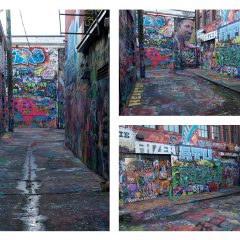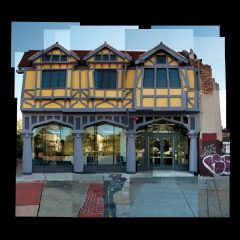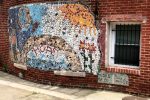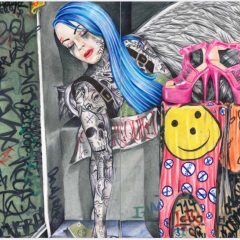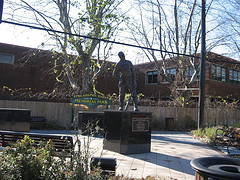
Philadelphia Stars Memorial Park, landscape designed by Synterra, Ltd.
While we’re on the subject of murals and public art and taste, the Negro Leagues baseball monument, which includes a sculpture, a mural and a pair of green plazas has been catching my eye each time I drive by 44th and Parkside on my way to points north of West Philadelphia.
The monument, which went up this past year, is where the Philadelphia Stars ballpark used to be, at 44th and Parkside. The Stars played there from 1933 to 1952. A list of all the Negro League teams of the time is etched into granite in the west plaza.
Although the mural is hard to miss with its corporate logos and heroic scale, it’s the more modest sculpure of the Philly Stars ballplayer that calls to me.
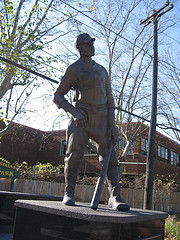
Phil Sumpter’s sculpture of a Philadelphia Stars batter
The bronze 7-foot figure (which seems far smaller), is by sculptor Phil Sumpter, and right off the bat I need to complain that the only sign of his authorship is his last name scratched into the sculpture itself on the back. The artist deserves more respect.
But the sculpture itself has all of my respect. His physical gesture is a blend of confidence, modesty and low-key athleticism. The scale seems not heroic–except for the giant hands–but the figure manages to communicate dignity, and its size and elevation on a pedestal evokes a contrast with the smaller sculpture of a Union Army soldier placed well up on a pedestal, several blocks due north at Belmont and Montgomery.
In the case of the batter, the pedestal elevates the figure, but does not put it beyond reach. Every one of the scale and placement judgments interests me.
The batter is placed on a corner with benches, pavements and plantings that suggest a baseball diamond without being a diamond. It’s pleasant, although because of the traffic at that corner, I can’t help but wonder how often people will sit there. I haven’t seen anyone, yet, although I drive by frequently.
Across the street is an enormous mural by David McShane and grassy plantings. The mural is part of the memorial, and of course it’s a part of the Philadelphia Mural Arts Program.
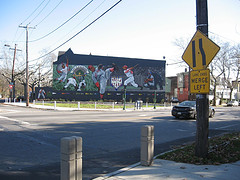
mural by David McShane
The mural is covered with giant logos and with ballplayers in action–figures that look pasted over a background that switches from pumped-up grass to a nostalgic black-and-white grandstand filled with fans.
Speeding by in my car, I see the heroic-scale ballplayers and the logos, then the giant grass, then the team penants. Last, I take in take in the grandstand (and I never decode the baseball as I’m flying by). It’s the grandstand part of the background that I love the most, because it’s in black and white–a good choice–and because it broadens the subject of the mural to include not only the players but the loyal fans, the community that supported the teams.
The mural seems designed to offer its image to cars on the move. However part of its background–the giant grass, the giant baseball–is a distraction, and the deliberate, pasted-on look of the figures is a puzzlement.
But even though I am not so crazy about the pumped up advertising flavor of this mural, I always give it a look, wondering at the giant pitcher with his foreshortened leg and pitching arm in motion for the windup; the batter, catcher and ump focused on the trajectory of the hit; the sliding tag; and the outfielder making a catch. I also like the small coach on the sidelines of the painting.
I can’t help but think about public art’s role in a community, and Andrea Kirsh’s comment that the art patrons of murals are not art insiders but communities, often blue-collar communities.
In raising this memorial for the Negro Leagues and the Philadelphia Stars, the backers–the Business Association of West Parkside–must have wanted to legitimize and publicly recognize a league whose members were barred from the majors. All in all, this memorial successfully projects pride of the community and the validity of the league. The sculpture communicates all this with gravity. To put it still another way, the sculpture has an art model, the mural, a business and commerce model.
However, my carping on some aspects of the mural is almost beside the point. The point is to write the African American faces into sports history, where they should have been written in the first place. Here they are written.


